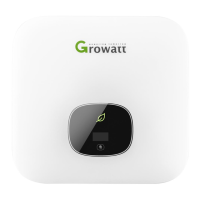Do you have a question about the Growatt MIN 8000TL-XE and is the answer not in the manual?
Unit converts PV DC to grid-compliant AC; built to safety rules; improper use causes hazards.
Grid-tied system requires connection to AC network by qualified personnel after approvals.
MIN TL-X Inverters designed to international safety requirements; follow instructions and cautions.
Inspect unit before installation; assemble per manual; cover array with dark material before connecting.
Live components cause injury/death; qualified persons only; residual voltage exists.
Ensure connectors are sealed; avoid touching hot parts; incorrect PV plant sizing can damage inverter.
Crucial safety warnings for installation, including fire, burns, radiation, and electrical hazards.
Guidance on choosing a suitable location, considering weight, visibility, airflow, humidity, and mounting orientation.
Instructions and diagram for mounting the inverter using a bracket.
Details on securely hanging the inverter on the bracket and fastening it.
Warnings about lethal voltages and electrostatic discharge during electrical connections.
Instructions for installing a circuit-breaker and wiring the AC output.
Conformance to IEC 61730, use of same brand connectors, and input types.
Safety warnings for DC connection, voltage limits, and disconnecting switches.
Connects inverter to AC grounding conductor; DC poles must not be grounded.
Steps to start the inverter, including safety warnings and touch control operations.
Procedure for starting the inverter by connecting AC breaker and turning on DC switch.
Steps for shutting down the inverter, including a DANGER warning.
What to do when error messages appear on the OLED, and information to provide Growatt.
Explains system faults and provides suggestions for common errors like AFCI, Residual I High, PV Voltage High, PV Isolation Low.
Lists warning codes for DC SPD, PV short circuit, dry contact, USB over-current, meter communication, EEPROM, firmware.
Lists error codes for Output High DCI, Bus sample fault, Relay fault, Over Temperature, etc.











